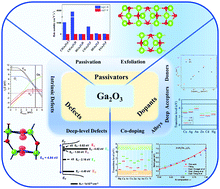Recent progress on the effects of impurities and defects on the properties of Ga2O3
Abstract
Ga2O3 is attractive for power devices and solar-blind ultraviolet photodetectors due to its ultra-wide bandgap, large breakdown field, and favorable stability. However, it is difficult to prepare the ideal Ga2O3 since there are plenty of defects (e.g., vacancies and interstitial atoms) in the bulk and films which can affect the physical properties of Ga2O3. Besides, the deep level defects act as trapped centers and have influence on the sensitivity and responsivity of optoelectronic devices. It has been discovered that doping is an effective strategy to modulate the properties of Ga2O3. In this review, the effects of defects and impurities on the material properties of Ga2O3 are mainly discussed. Considering that β-Ga2O3 is the most stable and the most studied currently, it is the main focus of this review. Firstly, the intrinsic properties (e.g., electronic, absorption, thermal and mechanical properties) of β-Ga2O3 are introduced, and then the influence of impurities (e.g., dopants and passivators) and defects on the electronic properties of β-Ga2O3 is discussed emphatically. Besides, the other properties (e.g., luminescence, magnetic, and piezoelectric properties) of β-Ga2O3 modulated by defects and impurities are also briefly discussed. Meanwhile, some new research directions are also worth exploring. These problems and potential directions are summarized and discussed in the last section.

- This article is part of the themed collection: Journal of Materials Chemistry C Emerging Investigators


 Please wait while we load your content...
Please wait while we load your content...